OSAMA BIN LADEN'S EARLY LIFE
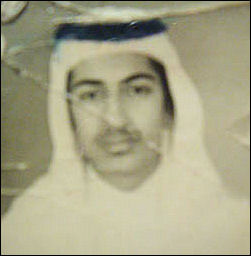
Osama bin Laden at 16 Osama bin Mohammed bin Awad bin Laden is believed to have been born in Riyadh, capital of Saudi Arabia, in 1957. He was the seventh son and 17th child of 24 sons and 54 children born to the Saudi business magnate, Mohammed bin Laden. His given name means “young lion,” the embodiment of courage and nobility. There was also a religious link. One of the companions of the prophet Muhammad was named Osama.
Many experts believe bin Laden was born in March 1957, though Steve Coll, in his book “The Bin Ladens: An Arabian Family in the American Century,” reported that Bin Laden himself said he was born in January 1958. In a 1998 interview, later broadcast on Al Jazeera, bin Laden said that he was born in Riyadh, the capital of Saudi Arabia, on March 10, 1957. “Then God was gracious to us as we went to Holy Medina six months after I was born,” he continued. The rest of his youth, he said, was spent in the western Saudi Arabian province known as the Hejaz, which lies between the Red Sea and central Arabia; it is the site of the two holiest cities in Islam, Mecca and Medina, where the most important events in the life of the Prophet Muhammad occurred. [Source: Steve Coll, The New Yorker, December 12, 2005]
John-Thor Dahlburg and Alex Rodriguez wrote in the Los Angeles Times: “He spent his youth in mansions filled with crystal chandeliers, gold statues and Italian tapestries. The elder Bin Laden was a devout Muslim, raised in the fundamentalist Wahhabi sect. He had at least 11 wives. Osama was the only child born to Alia Ghanem, a beauty from Syria who preferred Parisian fashions to the veil. As a foreigner, she did not rank high in the family pecking order. Some members of the Bin Laden clan have said her status was so lowly that she was known as "the slave" and her son as "ibn al abida" — son of the slave. Some sources close to the family believe his sense of alienation and rebellion began here. Others believe it arose later, when Bin Laden was maneuvered out of a major role in the construction firm by his older brothers.[Source: John-Thor Dahlburg and Alex Rodriguez, Los Angeles Times May 2, 2011]
Kate Zernike and Michael T. Kaufman wrote in the New York Times: “He was the only the child of his mother and grew up as kind of a loner within a family in which alliances of sibling was important to get the attention of their father, mothers and guardians...Some paint a portrait of Bin Laden as a misfit. His mother, the last of his father’s four wives, was from Syria, and was the only one not from Saudi Arabia. The elder Bin Laden had met her on a vacation, and Osama was their only child. Within the family, she was said to be known as “the slave” and Osama “the slave child.” [Source: Kate Zernike and Michael T. Kaufman, New York Times, May 2, 2011]
“Within the Saudi elite, it was rare to have both parents born outside the kingdom. In a profile of Osama bin Laden in The New Yorker, Mary Anne Weaver quoted a family friend who suggested that he had felt alienated in a culture so obsessed with lineage. “It must have been difficult for him,” the family friend said. “Osama was almost a double outsider. His paternal roots are in Yemen, and within the family his mother was a double outsider as well — she was neither Saudi nor Yemeni but Syrian.”
“Muhammad bin Laden died in a plane crash in 1967, when Osama was 10. The siblings each inherited millions — the precise amount was a matter of some debate — and led a life of near-royalty. Osama...grew up playing with Saudi princes and had his own stable of horses by age 15....Though never estranged from his family, Osama grew up in a separate household in Jeddah, with a stepfather whom Mohamed chose. From time to time, he journeyed to Syria for visits with his mother's kin. Coll's interviews with family members and classmates paint him as an unusually timid boy, but otherwise quite average.”
Osama bin Laden’s Teenage Years
After Mohamed's death bin Laden went to a good private school in Jeddah and lived with his mother. In his teens, he became involved with an Islamic study group and later joined the Muslim Brotherhood, an organization that promoted fundamentalist values. At 17, he married a 14-year-old cousin, the first of his four wives. She quickly bore him a son and was kept secluded according to strict Islamic tradition. [Source:Milton Viorst, Washington Post March 30, 2008; The Bin Ladens: An Arabian Family in the American Century by Steve Coll (Penguin Press, 2008)]
Bin Laden spent his teenage years in concrete house in an area of walled compounds in Jeddha. Osama had a ground floor bedroom. A friend from that period told The New Yorker he spent a lot of time watching television and was obsessed with the news. [Source: Steve Coll, The New Yorker , May 16, 2011]
John-Thor Dahlburg and Alex Rodriguez wrote in the Los Angeles Times: “From age 13, Bin Laden attended the Western-style Al Thagher Model School in the Saudi port city of Jidda. The teacher who tutored him in English remembers a tall, handsome and unfailingly polite teenager who stood out because of his serene self-confidence.” [Source: John-Thor Dahlburg and Alex Rodriguez, Los Angeles Times May 2, 2011]
Osama bin Laden’s Education
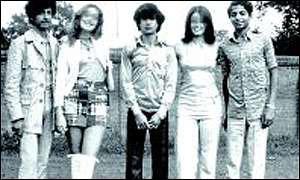
Picture allegedly of Osama bin Laden
at Oxford (on the extreme right) Most of the bin Laden boys were often sent abroad to attend boarding school. The girls and a few boys, including Osama bin Laden, remained in Saudi Arabia. Osama bin Laden’s brother Yeslam Binladin told Newsweek, “My father always encouraged us to be tolerant and open-minded...This who were educated in Saudi Arabia were raised in a cosmopolitan way, and some like, Osama, received more religious training, I know Osama is more religious and has a different mentality than the rest of the family.”
Bin Laden did well at school in commerce and technology. Although later in life he issud fatwas and acted as a religious leader, Osama bin Laden had no formal theological training. He was essentially as pretender as a Muslim cleric.
Osama bin Laden attended a private boys school in Jeddha, with a conservative Muslim religious orientation but also where students wore Western clothes and studied English. Kate Zernike and Michael T. Kaufman wrote in the New York Times: “Bin Laden had been educated — and, indeed, steeped, as many Saudi children are — in Wahhabism, a puritanical, ardently anti-Western strain of Islam. Even years later, he so despised the Saudi ruling family’s coziness with Western nations that he refused to refer to Saudi Arabia by its modern name, instead calling it “the Country of the Two Holy Places.” [Source: Kate Zernike and Michael T. Kaufman, New York Times, May 2, 2011]
Brian Fyfield-Shayler, a British citizen who lived in Saudi Arabia and taught English to a number of the bin Laden boys, told the writer Peter Bergen: “All the sons are very good-looking. I don’t think that I have ever met any ugly bin Ladens....This was my fourth year teaching, when [Osama] came along [in 1968, when he was 11]. Osama was one of 30 students. He [used to sit] two-thirds of the way back on the window side that looked out onto sports fields and playing grounds. Why did I remember Osama? First of all, I would have noticed because of his name, because of the family, and, of course, when you walked into a class of anyone of his age, he was literally outstanding because he was taller than his contemporaries, and so he was very noticeable. His English was not amazing. He was not one of the great brains of that class. [Source: Peter Bergen, Vanity Fair, January 2006]
Osama bin Laden’s Middle School and High School
Steve Coll wrote in The New Yorker: Osama bin Laden’s old school — the Al Thagher Model School — sits on several dozen arid acres lined by eucalyptus trees, whose branches have been twisted by winds from the Red Sea. The campus spreads north from the Old Mecca Road, near downtown Jedda, the Saudi Arabian port city where bin Laden spent most of his childhood and teen-age years. The school’s main building is a two-story rectangle constructed from concrete and fieldstone in a featureless modern style. Inside, dim hallways connect two wings of classrooms. In bin Laden’s day — he graduated in 1976 — there was a wing for middle-school students, and another for the high school. Between them is a spacious interior courtyard, and from the second floor students could lean over balcony railings and shout at their classmates below, or pelt them with wads of paper.” [Source: Steve Coll, The New Yorker, December 12, 2005]
“During the nineteen-sixties and early seventies, Al Thagher was the most prestigious high school in Jedda; compared with other schools in Saudi Arabia, it had a relatively secular flavor. Many wealthy Saudi parents sent their sons abroad for secondary education — to Lebanon, Egypt, England, or the United States — but for those who kept their boys in Jedda “Al Thagher was the school of the élite,” Saleha Abedin, a longtime Jedda educator, said. (Abedin is now a vice-dean of Jedda’s Dar Al-Hekma College, a private women’s college.) Al Thagher — the name means, roughly, “the haven” — was founded in the early nineteen-fifties, initially in the nearby city of Taif, with support from Faisal bin Abdul Aziz, who became the King of Saudi Arabia in 1964...The Al Thagher Model School showcased Faisal’s interest in science and Western methods of education; in the nineteen-sixties, it was the only school in Jedda with air-conditioning. Its students did not wear the national dress, a thobe and cloth headdress, but, rather, a uniform that imitated the styles of English and American prep schools: white button-down shirts with ties, gray slacks, black shoes and socks, and, in the winter months, charcoal blazers.”

Jeddah
“Each year’s graduating class numbered about sixty boys. Among them were young princes from the Saudi royal family, as well as privileged commoners like bin Laden. Every morning, the students would assemble in rows for a military-style call to order; on a stool to one side sat a schoolmaster with a cane, ready to discipline boys who misbehaved, by beating them on the soles of their bare feet. The school’s curriculum included English-language instruction given by teachers from Ireland and England and demanding courses in mathematics. At the same time, as with all institutions in Saudi Arabia, Al Thagher adhered to Islamic ritual. At midday, students would kneel together for the Zuhr, or noon prayer.”
Brian Fyfield-Shayler, a Briton who taught English at Al Thagher, told The New Yorker that when bin Laden arrived at the school he was already unusually tall. He was not, however, a particularly forceful personality. In an intermediate-English class, “I was trying to push the spoken aspects of the language,” Fyfield-Shayler recalled in an interview for a documentary film produced in Britain last year. “To succeed, the student needs to be prepared to make mistakes. They need to make a bit of an exhibition of themselves, and Osama was rather shy and reserved and perhaps a little afraid of making mistakes.” Seamus O’Brien, an Irishman who taught English at Al Thagher, told me that he remembers Osama as “a nice fellow and a good student. There were no problems with him. . . . He was a quiet lad. I suppose silent waters run deep.”
Kate Zernike and Michael T. Kaufman wrote in the New York Times: “Bin Laden had been educated — and, indeed, steeped, as many Saudi children are — in Wahhabism, a puritanical, ardently anti-Western strain of Islam. Even years later, he so despised the Saudi ruling family’s coziness with Western nations that he refused to refer to Saudi Arabia by its modern name, instead calling it “the Country of the Two Holy Places.” [Source: Kate Zernike and Michael T. Kaufman, New York Times, May 2, 2011]
Islamic Influences in Osama bin Laden in Middle School and High School
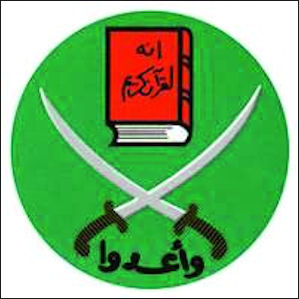
Muslim Brotherhood emblem Steve Coll wrote in The New Yorker: Most Al Thagher students, including bin Laden, were commuters, but there were a few boarders; they lived on the second floor, as did some of the school’s foreign teachers. It was in this upstairs dormitory, a schoolmate of bin Laden’s told me, that a young Syrian physical-education teacher led an after-school Islamic study group for a few outstanding boys, and it was there, beginning at about age fourteen, that bin Laden received his first formal education in some of the precepts of violent jihad.[Source: Steve Coll, The New Yorker, December 12, 2005]
“A schoolmate of bin Laden’s told me that during the eighth or ninth grade, around 1971 or 1972, bin Laden was invited to join the Islamic study group. In that period at Saudi high schools and universities, it was common to find Syrian and Egyptian teachers, many of whom had become involved with dissident Islamist political groups in their home countries. Some of these teachers were members of, or were influenced by, the Muslim Brotherhood, an Islamist organization founded in Egypt in 1928 by a schoolteacher, Hassan al-Banna.”
“In Saudi Arabia during the nineteen-sixties, King Faisal welcomed exiled teachers from Syria, Egypt, and Jordan, even if they were influenced by the Brotherhood, because he believed that they had been unfairly persecuted for their religious and political beliefs. He also hoped that their emphasis on Islamic teachings might help to inoculate Saudi Arabia against ideas such as socialism and secular pan-Arab nationalism, which were then spreading through Arab societies. Moreover, as he expanded Saudi Arabia’s schools, Faisal faced a shortage of qualified instructors of all kinds. The King “needed teachers,” Khaled al-Maeena, a prominent Jedda newspaper editor, told me. “Where would you get them?” Egypt and Syria offered Saudi Arabia a ready source at a time when the kingdom, barely a generation removed from widespread poverty and illiteracy, was struggling to produce teachers from its own population.”
“Formal political activity was banned in Saudi Arabia, so the Brotherhood-influenced teachers had to be careful. “When they came here, they realized the system does not allow any association” that might smack of politics, said Muhammad Salahuddin, a magazine publisher and journalist in Jedda who came to Saudi Arabia from Egypt. Rather than organize a political network, the teachers often introduced their students more informally to the Brotherhood’s precepts of Islamic activism, political consciousness, and violent jihad against Christian occupiers or secular leaders. The principal mission at Al Thagher, as laid out by the headmaster and wealthy supporters in the Jedda merchant community, was to prepare élite young Saudis for roles in the kingdom’s modernizing economy; it had nothing to do with the Brotherhood’s goals. The after-school Islamic study group that bin Laden joined was initially offered to exceptional students with the promise of earning extra credit.”
Osama bin Laden’s High School Islamic Study Group
Steve Coll wrote in The New Yorker that Bin Laden’s experience in the group was described by a schoolmate who asked not to be further identified, because, he said, he did not want to risk reprisals from bin Laden’s sympathizers. “The Syrian physical-education teacher who led the group at Al Thagher was “tall, young, in his late twenties, very fit,” the schoolmate recalled. “He had a beard — not a long beard like a mullah, however. He didn’t look like he was religious. . . . He walked like an athlete, upright and confident. He was very popular. He was charismatic. He used humor, but it was planned humor, very reserved. He would plan some jokes to break the ice with us. [Source: Steve Coll, The New Yorker, December 12, 2005]
“Some of us were athletes, some of us were not,” the schoolmate said of the group’s initial membership, which, besides bin Laden, included the sons of several prominent Jedda families. The Syrian “promised that if we stayed we could be part of a sports club, play soccer. I very much wanted to play soccer. So we began to stay after school with him from two o’clock until five. When it began, he explained that at the beginning of the session we would spend a little bit of time indoors at first, memorizing a few verses from the Koran each day, and then we would go play football. The idea was that if we memorized a few verses each day before soccer, by the time we finished high school we would have memorized the entire Koran, a special distinction.
At first, the study group proceeded as the teacher had promised. “We’d sit down, read a few verses of the Koran, translate or discuss how it should be interpreted, and many points of view would be offered. Then he’d send us out to the field. He had the key to the goodies — the lockers where the balls and athletic equipment were kept. But it turned out that the athletic part of it was just disorganized, an add-on. There was no organized soccer. I ended up playing a lot of one-on-one soccer, which is not very much fun.”
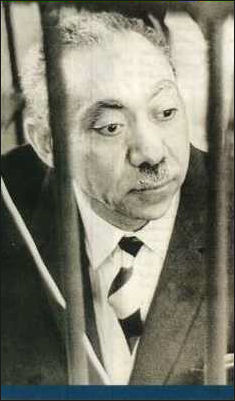
Sayyid Qutb, Muslim
Brotherhood theorist As time passed, the group spent more and more time inside. After about a year, bin Laden’s schoolmate said, he began to feel trapped and bored, but by then the group had developed a sense of camaraderie, with bin Laden emerging as one of its committed participants. Gradually, the teen-agers stopped memorizing the Koran and began to read and discuss hadiths, interpretive stories of the life of the Prophet Muhammad, of varied provenance, which are normally studied to help illuminate the ideas imparted by the Koran. The after-school study sessions took place in the Syrian gym teacher’s room, on the second floor. The teacher would light a candle on a table in the middle of the room, and the boys, including bin Laden, would sit on the floor and listen. The stories that the Syrian told were ambiguous as to time and place, the schoolmate recalled, and they were not explicitly set in the time of the Prophet, as are traditional hadiths. “It was mesmerizing,” he said, and increasingly the Syrian teacher told them “stories that were really violent. I can’t remember all of them now, except for one.”
It was a story “about a boy who found God — exactly like us, our age. He wanted to please God and he found that his father was standing in his way. The father was pulling the rug out from under him when he went to pray.” The Syrian “told the story slowly, but he was referring to “this brave boy” or “this righteous boy” as he moved toward the story’s climax. He explained that the father had a gun. He went through twenty minutes of the boy’s preparation, step by step — the bullets, loading the gun, making a plan. Finally, the boy shot the father.” As he recounted this climax, the Syrian declared, “Lord be praised — Islam was released in that home.” As the schoolmate recounted it, “I watched the other boys, fourteen-year-old boys, their mouths open. By the grace of God, I said “No” to myself. . . . I had a feeling of anxiety. I began immediately to think of excuses and how I could avoid coming back.” The next day, he stopped attending the after-school sessions. Eventually, after an awkward period of pulling away from his study-group friends, he joined a different circle of boys.
Osama bin Laden in His High School Islamic Study Group
Steve Coll wrote in The New Yorker: “Osama was an honorable student,” the schoolmate continued. “He kept to himself, but he was honest. If you brought a sandwich to school, people would often steal it as a joke or eat it if you left it on the desk. This was a common thing. We used to leave our valuables with Osama, because he never cheated. He was sober, serious. He didn’t cheat or copy from others, but he didn’t hide his paper, either, if others wanted to look over his shoulder.” [Source: Steve Coll, The New Yorker, December 12, 2005]
During the next several years, he said, he watched as bin Laden and the others in his former group, who continued to study with the Syrian, openly adopted the styles and convictions of teen-age Islamic activists. They let their young beards grow, shortened their trouser legs, and declined to iron their shirts (ostensibly to imitate the style of the Prophet’s dress), and, increasingly, they lectured or debated other students at Al Thagher about the urgent need to restore pure Islamic law across the Arab world. It is unclear whether the Syrian teacher was a member of the Muslim Brotherhood or was simply influenced by some of its ideas about political activism and violent jihad against unbelievers; his whereabouts today are unknown. Bin Laden’s schoolmate said the teacher left Al Thagher twenty-five years ago.
High school shaped bin Laden’s future in another way as well. In Afghanistan, he worked at times with a former Al Thagher biology teacher, a Saudi named Ahmed Badeeb. During the nineteen-eighties, Badeeb took up a new job, as chief of staff for Prince Turki al-Faisal, who was then the head of Saudi intelligence and whose department, in collaboration with the C.I.A., sent hundreds of millions of dollars to support the Afghan war effort. In describing his occasional work with bin Laden on the Afghan frontier, Badeeb has said that they enjoyed a warm personal relationship, one that had its origins in their shared experiences at Al Thagher.
Osama bin Laden’s University Years
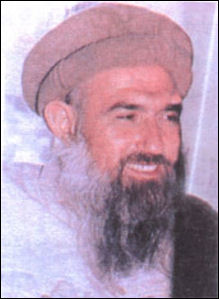
Abdullah Azzam After completing high school in 1974, Bin Laden did not follow his brothers to higher education in the West, but instead enrolled in the management and economics program at King Abdul Aziz University in Jeddha. He studied economics and civil engineering. Some described him as more scholarly than religious but said he certainly was not a Muslim extremist. All of the Bin Laden children were required to work for the family company, meaning that Osama spent summers working on road projects.
At university he joined the Muslim Brotherhood and studied under two clerics with strong ties to the Muslim Brotherhood “the Palestinian Sheikh Abdallah Azzam and the write and the Egyptian philosopher Mohammed Quttub — who later became influential in Afghanistan. Muhammad Qutb was the brother of Sayyid Qutb had written one of the Brotherhood’s most important tracts about anti-Western jihad, “Signposts on the Road.” (Sayyid Qutb was hanged for treason by the Egyptian government in 1966.)
Jamal Khalifa, recalling his years with bin Laden at Jidda’s King Abdul Aziz University told Peter Bergen: “In “76, I met Osama. He was in a different college, in economics. I was in science, but our activities were the same. I was almost 20, and he was 19. At that time we were religious and very much conservative. Of course, no girls — don’t even talk about it — and no photographs. That’s why I don’t have any pictures with Osama. I was photographed in high school, but when I became religious I threw everything away.” [Source: Peter Bergen, Vanity Fair, January 2006]
“We [discussed] polygamy, and we recalled our fathers, how they practiced polygamy. We found that they were practicing it in a wrong way, where they married and divorced, married and divorced — a lot of wives. Some of those practicing polygamy will, if they marry the second one, neglect the first one — not the Islamic way at all. And we look at polygamy as solving a social problem, especially when it’s confirmed that there are more women than men in the society. It’s not fun, it’s not a matter of just having women with you to sleep with — it’s a solution for a problem. So that’s how [Osama and I] looked at it, and we decided to practice [polygamy] and to be a model.”
Jamal Khashoggi, a Saudi journalist who knew bin Laden in Jedda, told Bergen: Osama was just like many of us who become part of the [Muslim] Brotherhood movement in Saudi Arabia. The only difference which set him apart from me and others, he was more religious, more literal, more fundamentalist. For example, he would not listen to music. He would not shake hands with a woman. He would not smoke. He would not watch television, unless it is news. He wouldn’t play cards. He would not put a picture on his wall. Even though he comes from a rich family, he lives in a very simple house.
Memories of Osama bin Laden’s Teenage Friend
Khaled Batarfi, moved in a few doors down from bin Laden in 1971 when bin Laden was 14. He was three years younger than bin Laden. They played on the same club soccer team. Batarfi old Peter Bergen: “I was the soccer captain even though Osama was older than me. Because he was tall, he used to play forward to use his head and put in the goals. I was a tough guy then and Osama was the peaceful one. He was very shy, very observant. He liked Western movies. One of the TV series he liked was Fury. [It ran on NBC from 1955 to 1960.] He used to watch that, and he liked karate movies. Bruce Lee. He liked to go climbing mountains in the area between Syria and Turkey. He loved horse riding.” Batarfi told The New Yorker a young man bin Laden drove a white Chrysler and a gray Mercedes, often very fast. [Source: Peter Bergen, Vanity Fair, January 2006]
“He would fast every Monday and Thursday. [Such] fasting is an extra thing, because it’s what the Prophet used to do, but you don’t have to do it. [Osama’s mother] is a moderate Muslim. She watches TV. She [has] never been very conservative, and her [current] husband’s like that; their kids are like that. So Osama was different, but then, he was different in a quiet way. He would bother his brothers sometimes for looking at the maid or things like that. Of course, he woke them for prayers in the morning, and that was good — nobody complained. But sometimes he was kind of upset if something is not done in an Islamic way. “Don’t wear short sleeves, don’t do this, don’t do that.” At 17 he married his cousin in Latakia [in Syria] — a beautiful resort, I hear — the daughter of his uncle, the brother of his mother. And then he went to the university and I saw less of him.”
Steve Coll wrote in The New Yorker: Although Batarfi did not attend Al Thagher, he saw bin Laden frequently during Osama’s years there. Over the course of several interviews, Batarfi told me that he witnessed his friend’s emergence during those years, at about age fifteen or sixteen, as an increasingly committed schoolyard Islamic activist. “In Al Thagher, he was part of an Islamic group,” Batarfi recalled. “He was a prominent member. . . . That group was influenced by the Brotherhood. He was influenced by this philosophy.”[Source: Steve Coll, The New Yorker, December 12, 2005]
In book, 2004 book “Osama,” longtime Middle East correspondent Jonathan Randal quoted Jamal Khashoggi, a former acquaintance of bin Laden as saying that Osama “grew up as a Muslim Brother” and did not split from the movement until the mid-nineteen-eighties. The Brotherhood’s influence on bin Laden was particularly striking, Batarfi told me, because the movement’s emphasis on the need for political transformation in the Muslim world differed from the more introspective Islamic theology then prevalent in Saudi Arabia.
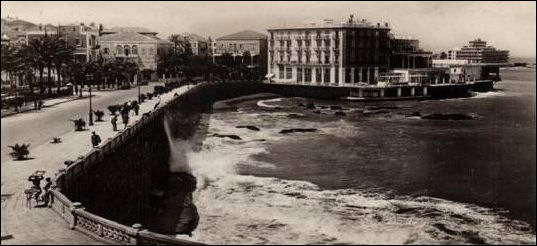
St. George hotel in Beirut
Osama bin Laden in His 20s: a Wild Playboy?
After Osama bin Laden graduated he joined his half-brothers in the family construction firm. There were reports that when Osama bin Laden was in his early 20 he was a kind of a playboy. According to to these reports he hung around in bars in Beirut and drank heaving and often got involved in fistfight and shouting matches.
John-Thor Dahlburg and Alex Rodriguez wrote in the Los Angeles Times: “Some sources claim that Bin Laden spent his vacations from high school and college in the fleshpots of Beirut, drinking and womanizing. By some accounts, Bin Laden renounced such impious behavior and began an intense study of the Koran after his father's company was awarded contracts to rebuild the Mecca and Medina mosques. Other accounts, perhaps embellished by his admirers, claim he was already an assiduous student of his faith as an adolescent. When he was about 18, relatives on his mother's side have said, Bin Laden was sent to Syria for his first bride, a 14-year-old named Najwa.” [Source: John-Thor Dahlburg and Alex Rodriguez, Los Angeles Times May 2, 2011]
Kate Zernike and Michael T. Kaufman wrote in the New York Times: “Newspapers have quoted anonymous sources — particularly an unidentified Lebanese barber — about a wild period of drinking and womanizing in Bin Laden’s life. But by most accounts he was devout and quiet. [Source: Kate Zernike and Michael T. Kaufman, New York Times, May 2, 2011]
Batarfi told Bergen: “Even after his marriage, for a year or so he was still living in his mother’s house. Later on, after he got his first child, it seems like it was too tight a place for him, especially since he was planning to marry another woman. So they moved to a building in the Al-Aziziyah district [in Jidda]. He gave each wife an apartment. I visited him once and I saw that they were bare apartments. I mean, I wouldn’t live there myself. Very humble.” [Source: Peter Bergen, Vanity Fair, January 2006]
Osama bin Laden in the West?
Some say that during his teenage years, Bin Laden also went on family vacations to Denmark, Sweden and Britain. Other say he has never been to the West. He has limited his travels to the Arabian peninsula, Syria, Pakistan, Afghanistan and Sudan. Reports that he traveled to the Philippines and Azerbaijan and that was a playboy in London they say are not true.
Steve Coll wrote in The New Yorker that according to Batarfi: On occasion, he joined gatherings of the larger bin Laden clan. By the early nineteen-seventies, this group, on his father’s side of the family, included a number of half brothers who had studied abroad, in places such as Lebanon and England. Some of Osama’s older half brothers had traveled to Europe and, occasionally, the United States.[Source: Steve Coll, The New Yorker, December 12, 2005]
Christina Akerblad, former owner of the Hotel Astoria in the town of Falun, Sweden, told Bergen that in 1970 Salem bin Laden, in his mid-20s, and his younger brother Osama paid a visit: They came with a big Rolls-Royce, and it was forbidden to park the car outside the building in this street. But they did it, and [my husband and I] said to them, You have to pay [a fine] for every day and every hour you are staying outside this hotel, but they said, “Oh, it doesn’t matter — it’s so funny to go to the police station and to talk with the police. We will stay where we are.” It was like a joke to them. They had so much money they didn’t know how much money they had. I asked them how they had managed to come to Sweden with this enormous Rolls-Royce. They said, “We have our plane.” [Source: Peter Bergen, Vanity Fair, January 2006]
They stayed one week. They were dressed very exclusive. They had two double rooms. They slept in one bed and on the other bed they had their bags. On Sunday, I had no cleaner at the hotel, so I took care of the room myself, and I was shocked because in the big bag they had lots of white, expensive shirts from Dior and Yves Saint Laurent. When they had [worn] the shirt once, they dropped it. So the cleaner had taken these shirts to wash them, but they said, “No, we are just using them once, so you can [have] them if you want.”
A Spanish women says she met Osama bin Laden in 1971 in Oxford, England, where he was attending language school with two of his brothers. She described him as a “deep” and “wonderful teenager” who found the foreigners in England “a bit crazy.”
Carmen bin Ladin, former wife of Yeslam bin Ladin, Osama’s older half-brother, said Osama bin Laden came to visit them in Britain. In her 2004 book, Inside the Kingdom she wrote: One day, Yeslam’s younger brother Osama came to visit. Back then he was a young student attending King Abdul Aziz University in [Jidda], respected in the family for his stern religious beliefs, and recently married to a Syrian niece of his mother’s. Catching sight of Osama and his [adult] nephew Mafouz, I smiled and asked them in. “Yeslam is here,” I assured them, but Osama snapped his head away when he saw me and glared back towards the gate. “No, really,” I insisted. “Come in.” In Saudi culture, any man who might one day become your husband is not supposed to see you unveiled. Osama was among those men who followed the rule strictly. [Source: Peter Bergen, Vanity Fair, January 2006]
Kate Zernike and Michael T. Kaufman wrote in the New York Times: “According to one of his brothers, Osama was the only Bin Laden child who never traveled abroad to study. A biography of Bin Laden provided to the PBS television program “Frontline” by an unidentified family friend asserted that Bin Laden had never traveled outside the Middle East. That lack of exposure to Western culture would prove a crucial distinction; the other siblings went on to lead lives that would not be unfamiliar to most Americans. They took over the family business, estimated to be worth billions, distributing Snapple drinks, Volkswagens and Disney products across the Middle East. On Sept. 11, 2001, several Bin Laden siblings were living in the United States. [Source: Kate Zernike and Michael T. Kaufman, New York Times, May 2, 2011]
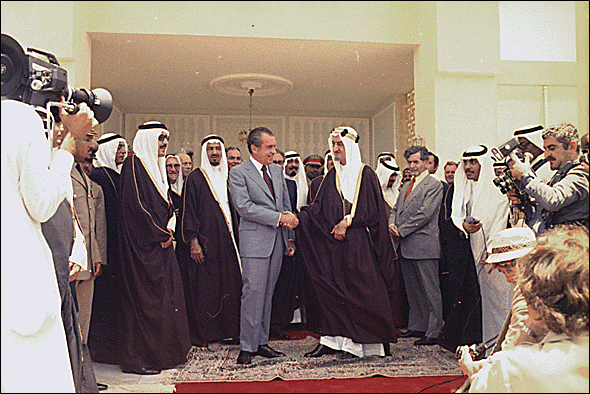
U.S. President Richard Nixon meets
Saudi Arabia's King Faisal at Riasa Palace in Saudi Arabia in July, 1974
Steve Coll wrote in The New Yorker: “The subject of Osama’s youthful travels has been muddled by a number of accounts of his teen-age years, published shortly after September 11th. These have included reports, for example, that bin Laden attended boarding school in Lebanon, where he supposedly engaged in drinking and disco dancing. Some of bin Laden’s half brothers did attend school in Lebanon, but no credible evidence has surfaced that Osama ever did. There have also been published reports that bin Laden joined his family on vacation in Sweden, and that he enrolled in a summer language course in England, but there is some uncertainty about these reports; several people who have met bin Laden say the reported trips amount to cases of mistaken identity. [Source: Steve Coll, The New Yorker, December 12, 2005]
“Khaled Batarfi offered a new account of bin Laden’s travels during the nineteen-sixties and seventies. He said that, as far as he knew, bin Laden had ventured outside the Middle East as a young man only three times. The first time, when he was about ten, he went to London with his mother to receive medical treatment for an eye condition. Bin Laden stayed in England for at least a month and did some sightseeing, according to Batarfi. On a second trip, as a teen-ager, bin Laden joined some friends and relatives on a big-game safari in East Africa. And, finally, according to Batarfi, Osama bin Laden made one trip to the United States, in about 1978.”
Osama bin Laden in the U.S.?
Batarfi told Bergen: Did you know he went to America? He took his [first] son, Abdallah, because Abdallah has problems with his head — it was deformed — so he took him for a medical trip.
Steve Coll wrote in The New Yorker: “According to Batarfi, the trip to America came about because bin Laden’s first child, a son named Abdullah, who was born in about 1976, had a medical problem — apparently cosmetic. Bin Laden, his wife, and his toddler son travelled together to the United States for treatment, Batarfi said, although he is not certain where the procedure took place. By his account, only one aspect of the journey made a particularly strong impression on bin Laden: On the way home, Osama and his wife were sitting in an airport lounge, waiting for their connecting flight. In keeping with their strict religious observance, his wife was dressed in a black abaya, a draping gown, as well as the full head covering often referred to as hijab. Other passengers in the airport “were staring at them,” Batarfi said, “and taking pictures.” When bin Laden returned to Jedda, he told people that the experience was like “being in a show.” By Batarfi’s account, bin Laden was not particularly bitter about all the stares and the photographs; rather, “he was joking about it.” [Source: Steve Coll, The New Yorker, December 12, 2005]
If Batarfi is correct, bin Laden’s American visit took place before he travelled to Afghanistan to participate in violent jihad, and about ten years before he founded Al Qaeda; it might never have surfaced in intelligence and law-enforcement investigations of bin Laden, which began in the midnineteen-nineties. Spokesmen at several government agencies, including the C.I.A. and the F.B.I., said that their Al Qaeda specialists had no information about a visit by bin Laden to the United States. A State Department spokesman said that its consular section had no record of ever having issued a visa to bin Laden, but that the department no longer has complete records of visas that were issued that long ago.
Text Sources: New York Times, Washington Post, Los Angeles Times, Times of London, The Guardian, National Geographic, The New Yorker, Time, Newsweek, Reuters, AP, AFP, Wall Street Journal, The Atlantic Monthly, The Economist, Global Viewpoint (Christian Science Monitor), Foreign Policy, Wikipedia, BBC, CNN, NBC News, Fox News and various books and other publications.
Last updated July 2012
